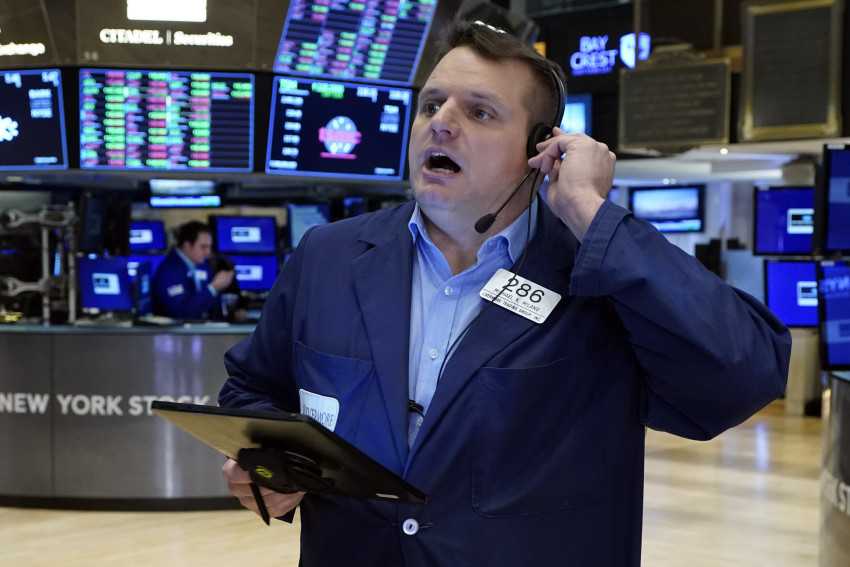Asia shares slip as investors weigh Omicron economic risks

Asian shares mostly slipped Tuesday as investors cautiously weighed how much damage the new Omicron coronavirus variant may unleash on the global economy. South Korea’s Kospi led regional losses with a 2.4% drop, to 2,839.01.
Japan's benchmark Nikkei 225 lost earlier gains and dropped 1.6% to 27,821.76, as pessimism over the Omicron variant set in. Australia's S&P/ASX 200 gained 0.2% to 7,256.00. Hong Kong's Hang Seng dipped 1.7% to 23, 439.91, while the Shanghai Composite was nearly flat at 3,563.89.
The yield on the 10-year Treasury slipped back to 1.46% from 1.51% late Monday. It tends to rise and fall with expectations for the U.S. economy’s strength and for inflation.
Some analysts think a serious economic downturn, like what happened last year, likely will be averted because many people have been vaccinated. But they also think a return to pre-pandemic levels of economic activity, especially in tourism, has been dramatically delayed.
“Sentiments may ride on the positive handover from Wall Street overnight, but with the slower vaccination rate and more limited healthcare capacity in the region, uncertainty from the new omicron variant may seem to bring about higher economic risks for the region at a time where it is shifting towards further reopening,” Yeap Jun Rong, market strategist at IG in Singapore, said of the omicron's impact on Asia.
The vaccination rollout rate varies by country in the region, at about 77% in Japan, 50% in Vietnam and 35% in Indonesia. In Asia, the omicron variant has only been detected in Australia and Hong Kong, but the region is bracing for its wider arrival. It is unclear how effective current vaccines may be against the new variant.
On Wall Street, the S&P 500 rose 1.3% to 4,655.27, recovering more than half of its drop Friday, which was its worst since February. Bond yields and crude oil also recovered chunks of what they lost in traders' knee-jerk reaction to run toward safety and away from risky investments.
The Nasdaq added 1.9% to 15,782.83. The Russell 2000 index of small companies slipped 0.2% to 2,241.98.
Given the uncertainty, the Dow Jones Industrial Average wavered between gains and losses, advancing 0.7% to 35,135.94.
The VIX, an index that measures how worried investors are about upcoming drops for the S&P 500, eased significantly. But it’s not all the way back to where it was before omicron.
But while the market steadied itself, omicron adds more risk to a global economy already contending with paralyzing uncertainty. The variant appears to spread more easily, and countries around the world have put up barriers to travel in hopes of stemming it.
Travel bans, including decisions by Japan and Israel to bar foreign visitors, threaten to disrupt global business. Global supply chains already gummed up by bottlenecks could be further ensnarled if outbreaks shut down factories, ports and freight yards.
Shipping problems would risk pushing prices higher, adding to inflation pressures. In response, the world’s central banks could raise interest rates and imperil the recovery from last year’s brief but intense coronavirus recession.
Besides waiting on more clues about how much economic damage omicron will ultimately do, the market has several big mileposts this week that could swing prices. The headliner is likely Friday's jobs report, where economists expect to see an acceleration in hiring by employers during November.
The U.S. economic recovery lost significant momentum when the highly contagious delta variant hit over the summer. Economic growth slowed to an annual rate of 2.1% from July through September from 6.7% from April through June.
Still, more Americans are vaccinated now, and the economy has shown resiliency, regaining speed after the summer slowdown.
Of course, the only way to know which scenario will ultimately occur is to wait to see it through. And that uncertainty in the meantime could lead to more up-and-down swings for the stock market, which has surged more than 24% this year and set a record as recently as Nov. 18.
In energy trading, benchmark U.S. crude dropped 3% or $2.10 to $67.85 a barrel. It rose $1.80 to 69.95 per barrel on Monday. Brent crude, the international standard, fell $2.52 to $70.70 a barrel.
In currency trading, the U.S. dollar slipped to 113.09 Japanese yen from 113.56 yen. The euro advanced to $1.1326 from $1.1291.
Tags :
Previous Story
- Asian stocks mixed after Fed says ready to...
- Malaysia set for economic contraction amid continued Covid...
- Highly educated Black and Asian Brits are disadvantaged...
- Chinese bourses gain leverage abroad
- Much-loved music player of the 2000s, Winamp, is...
- China loses status as world's second-largest stock market...